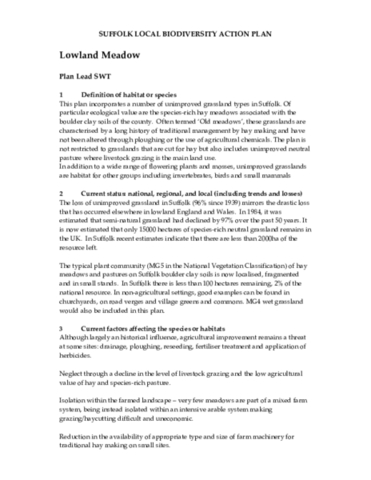Lowland Meadows
Hay meadows and unimproved grasslands on well-drained neutral soils with grassy swards and an abundance of herbs.
Home to some uncommon plant species and are an important food source for grazing mammals, invertebrates and birds.
Developed from, and maintained by, grazing and/or mowing.
Importance for wildlife
Lowland meadows are important for wildlife as the vast majority of this habitat has been lost. They are species-rich with a wide range of plants and grasses, which generally occur in a relatively small area. The sward is characterised by fine-leaved grasses including Sweet Vernalgrass, which gives hay its distinct sweet scent. The variety and abundance of flowering plants within semi-natural habitats provide good sources of pollen and nectar for many of our pollinating insects such as bumblebees, hoverflies, butterflies and moths. The rich population of invertebrates provide food for birds, bats and other small mammals.
Important associated species
Birds
- Common Starling Sturnus vulgaris
- Black-tailed Godwit Limosa limosa
- Common Cuckoo Cuculus canorus
- Eurasian Curlew Numenius arquata
- Corn Bunting Miliaria calandra
- Grey Partridge Perdix perdix
- Yellow Wagtail Motacilla flava
- Northern Lapwing Vanellus vanellus
- Reed Bunting Emberiza schoeniclus
- Skylark Alauda arvensis
- Yellowhammer Emberiza citrinella
- Barn Owl Tyto alba*
Mammals
- Harvest Mouse Micromys minutus
- Hedgehog Erinaceus europaeus
Bees and Wasps
- Brown-Banded Carder Bee Bombus humilis
- Large Garden Bumblebee Bombus ruderatus
- Red-Shanked Carder-bee Bombus ruderarius
Reptiles and Amphibians
- Grass Snake Natrix natrix
- Slow Worm Anguis fragilis
Moths
- The Forester Adscita statices
- Grey Dagger Acronicta psi**
- Brown-spot Pinion Agrochola litura**
- Beaded Chestnut Agrochola lychnidis**
- Ear Moth Amphipoea oculea**
- Dusky Brocade Apamea remissa**
- Garden Tiger Arctia caja**
- Galium Carpet Epirrhoe galiata (coastal)**
- Autumnal Rustic Eugnorisma glareosa (light sandy soils)**
- Spinach Eulithis mellinata**
- Garden Dart Euxoa nigricans**
- White-line Dart Euxoa tritici**
- Small Emerald Hemistola chrysoprasaria**
- Ghost Moth Hepialus humuli**
Plants
- Frog Orchid Dactylorhiza viridis
*Suffolk Priority species
**Priority - Research Only. Common and widespread, but rapidly declining
Factors affecting habitat in Suffolk
- Agricultural improvement remains a threat: drainage, ploughing, reseeding, application of fertiliser, pesticides and herbicides, conversion to arable and a shift from hay-making to silage production
- Neglect through a decline in livestock grazing and the low value of hay and species-rich pasture
- Isolation and lack of appropriate machinery make grazing/haycutting uneconomic on small sites
- Lack of resources for the management of non-agricultural sites. Inappropriate grazing/cutting regimes e.g. intensive grazing (often horse) or regular topping.
- Changes in the timing of hay cutting
- Abandonment leading to rank over growth and scrub encroachment
- Dehydration through lowered water tables due to water abstraction and the effects of drought
- Eutrophication through atmospheric pollution and run-off. Climate change apparently increasing growth rates and therefore altering/increasing necessary management
Habitat management advice
- Land reclamation techniques such as use of fertilisers, drainage and reseeding, can result in habitat loss or damage and should be prevented.
- Lowland meadows are best managed by light, extensive grazing (cattle grazing is preferred). Undergrazing and/or overgrazing should be avoided. The risk of poaching should be minimised and any livestock removed off-site in very wet conditions.
- Where the historical management of the habitat has been for hay production, this should continue. Cutting should be delayed until after mid-July, this will allow plants to flower and set seed. Aftermath grazing should be carried out in late summer and autumn to keep the sward low and assist seed germination.
- Where hay is produced on lowland meadow small amounts (less than 2.5 tonnes/ha/year) of farm yard manure may be applied. No other form of nutrient inputs should be applied as it would reduce species-richness and diversity with a loss of nature conservation value.
- Encroaching scrub and tussock forming rushes should be controlled by cutting as these can spread at the expense of the priority habitat. Machinery should only be used where ground conditions permit.
- Trees should not be planted on this grassland type because the shade and leaf litter cast by trees can lead to losses of grassland plants and a reduction in botanical diversity and nor should it be used for supplementary feeding or storage areas.
Vision for Suffolk
- Improve knowledge of extent and quality of lowland meadows.
- Maintain the existing extent of lowland meadows to ensure no net loss.
- Re-create lowland meadows as opportunities arise.
- Encourage the restoration and improvement of degraded lowland meadows.
Where to find further information
- Buglife – advice on managing BAP habitats
- Buglife – Notable invertebrates (pdf)
- Fen Management Handbook (pdf)
- JNCC – Habitat Description (pdf)
- MAGIC website – interactive mapping information including designations
- Magnificent Meadows – Recovery (pdf), technical information and management guides
- Making Space for Nature, a Review of England’s Wildlife Sites and Ecological Network 16 Sep 2010. Chaired by Professor Sir John Lawton CBE FRS. Defra website (pdf)
- Natural England – An illustrated guide to managing neutral pasture for wildlife (TIN088)
- Natural Environment White Paper June 2011 – The Natural Choice: securing the value of nature (pdf)
- Plantlife – Meadows hub
- Suffolk Wildlife Trust – Habitats Explorer
* all the links marked (pdf) have been gathered into an Issuu stack
Images:
- Cowslips by Paul Clarke (Flickr)
- Slow Worm by Paul Kitchener (Flickr)
- Bee Orchid by Matt Berry/Greenwings Wildlife Holiday (Flickr)
- Yellow Wagtail by Neil Rolph (Flickr)






